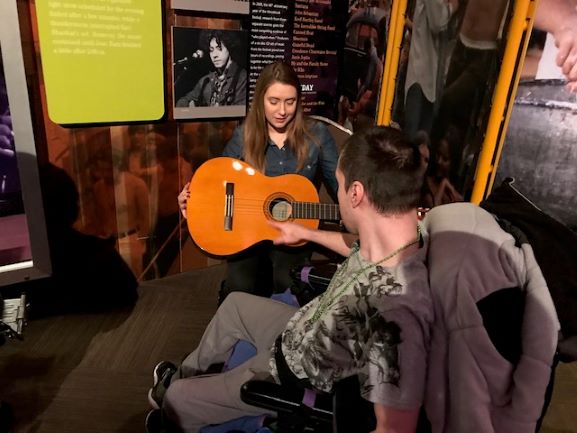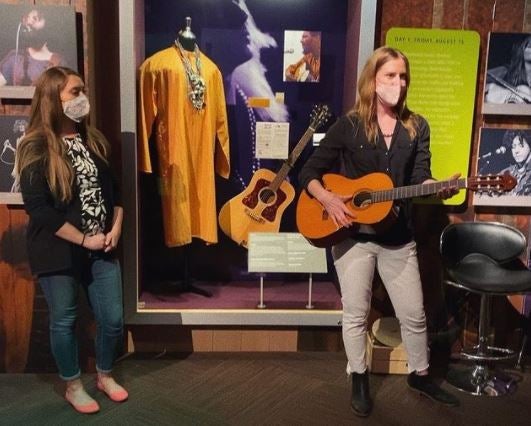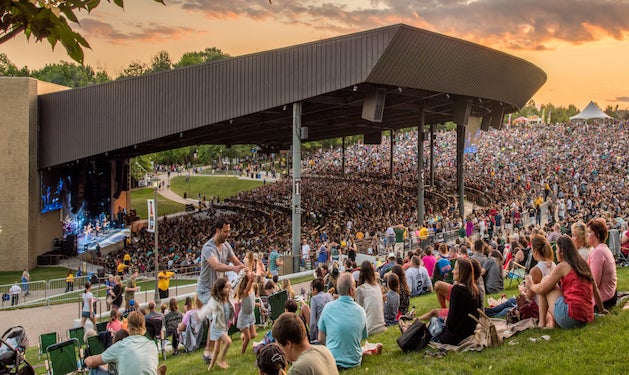Behind-The-Scenes of Sensory-Friendly Days at Bethel Woods
The Museum at Bethel Woods Preservation Fellow Eleanor Hein discusses Sensory-Friendly Museum Days with Museum Curator Julia Fell and Lead Teaching Artist Candace Rivela.
2021 has come with the challenge of change.
For the Museum at Bethel Woods, change has taken several different faces. If you have been a follower of the Museum for a while now, you might have noticed some of them, appearing in a combination of creating new and utilizing existing resources (as is the nature of any history-focused institution: a blending of things new and old). Among these faces of change is a new program aimed at broadening Museum audiences through inclusive practices: Sensory-Friendly Museum Days.
The sensory-friendly museum experience is not singular to the Museum at Bethel Woods. In fact, the Museum took inspiration from a host of other institutions that have been joining the movement of inclusive practice in accessible programming. Bethel Woods is proud to join this growing practice. The more museums (and the greater accessibility to them), the better!

A consideration museums must make when it comes to inclusion is: “Who is being overlooked in our institution and why?” It is desirable in mainstream museum practice to try to appeal to all five of guests' senses in order to provide an immersive and engaging experience that will leave a lasting impression. For many, this approach is effective and even expected. However, human experiences are incredibly diverse, so those strategies which may be enjoyable for some people can just as easily be stressful or unpleasant for others. It can exclude entire communities, such as autistic and other neuro-diverse people, who have varied sensory needs and preferences.
The solution is not as simple as adjusting how “sensational” an exhibit is. With humans being so diverse on a multitude of spectrums, there is no ideal method for communicating museum stories that be appealing to everybody. Organizations such as the Smithsonian Institution and the American Alliance of Museums have published resources outlining best practices and ideas for museum accessibility, including sensory accessibility. Many museums have adopted special days and times for visitors with autism, developmental disabilities, sensory sensitivities, and other complex conditions.
Curious to find out more about the Sensory Friendly Museum Days, I reached out to two of the organizers to better understand what went into developing this program and what the future of sensory-friendly programming at Bethel Woods might look like. I will start by introducing the two women who made the program a reality.
Candace Rivela is the Lead Teaching Artist and a Licensed Creative Arts Therapist in the Museum Education and Creative Programs (MECP) department here at Bethel Woods. Her inspiration comes from witnessing the transformative power of the arts firsthand. She told me, “Watching someone’s personal creative process is a humbling and rewarding experience.” Engagement in creative arts is rewarding to all involved parties, and in my short time working here, it has been abundantly apparent to me that the programs Candace has implemented and managed are imbued with intentions of inclusion and self-advocacy.
Julia Fell is the Assistant Curator at the Museum at Bethel Woods. She is driven to create and increase access in history. “Oftentimes,” she explained, “this means using a diversity of objects and stories to create many ‘entry points into history’ that anyone can connect with.” Access, especially in the case of the Sensory-Friendly Museum, means considering all aspects of the museum, from physical spaces to communicated content.

This idea merged naturally with the goals of the Museum at Bethel Woods. Julia had been wanting to expand inclusive efforts at the Museum: “I knew that we were missing out on sharing our space with many people who could enjoy and appreciate what we have, if only we took a few steps to make it accessible,” Julia told me. She saw museums implementing sensory-friendly adaptive programming and knew that the Museum at Bethel Woods needed to join them.
Preparations for the program began in 2019 by surveying Sullivan County to better understand the general population and the prevalence of communities with developmental disabilities. The intent was more than understanding demographics: Candace and Julia needed to know specifically what services were available to autistic and developmentally-disabled residents of the county, and which were not.
It was vital to consult and include direct sources to pinpoint community needs. Consulting with community partners garnered informed and empathetic planning for the program. Candace teamed up with two organizations: The Center for Discovery and New Hope Community. These local institutions partnered with the Museum to provide informed staff training, critical suggestions for program implementation, and interested participants from within their networks to beta test the program and offer essential feedback.
The result is a once-monthly morning program providing early access to the Museum, specifically catered toward visitors with sensory sensitivities.
What does this look like?
Aspects of the Museum galleries geared toward sensory stimulation have been adapted and controlled to give visitors jurisdiction over their experience. Sound and lighting features in the Main Exhibit are augmented to reduce sensory stimulation. Certain portions of the exhibit are designated for more or less stimulation, giving visitors the choice of engaging to whatever extent they are comfortable. Staff and volunteers are trained and available to assist guests in navigating the exhibition, engaging in interactive explorations, and answering questions about any displays.
While the program is still operating as a pilot program, the Museum intends for it to become a permanent offering. With continued feedback from participants and caregivers, Julia and Candace hope to expand the Museum’s accessibility and the communities served.
Between Candace’s educational expertise, Julia’s museum prowess, and overlapping values of creativity and inclusion, the two of them have worked together to generate a program with the intention to grow and improve for the foreseeable future. “Our visitors with sensory needs and complex conditions aren’t going anywhere,” Julia said, “and I want to continue to be available to them and their families.” I, personally, am very much looking forward to seeing what advances in inclusion and accessibility are made here at the Museum through Julia and Candace’s continued efforts!
Sensory Friendly Museum Days are held on the second Saturday of each month. Tickets cost $10 per person, and caregivers receive free admission.
